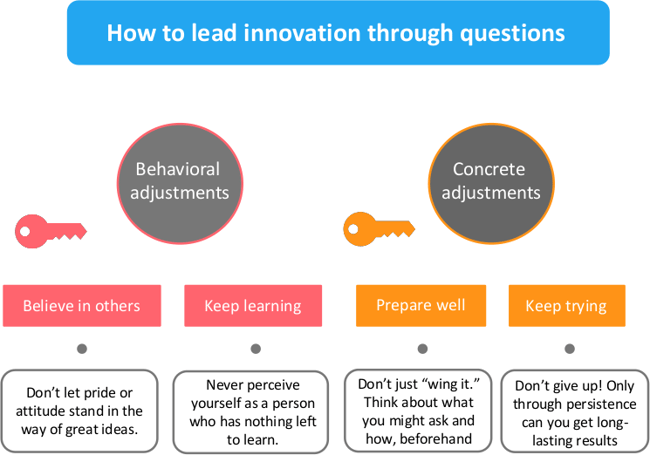Leading Innovation Through Questions – Why You Should Ask Questions and Not Provide Answers
"Don’t come to me with questions, come to me with answers!”
If this sounds familiar, you’ve probably either managed or been managed in a way that may not be the best in terms of promoting creative growth in individuals. From the beginning of the information age, innovation has been a hot topic, and for innovation to thrive, so must creativity. The fundamental problem with the industrial era mentality of efficiency is that it suffocates creativity and enforces blindfolded execution without critical thinking. Although it’s good to have your employees be efficient, it is in fact effectiveness that determines whether you succeed or fail in the information era.
Communicating Through Questions
To promote effective thinking, there might a clever way to spark creativity through seemingly standard communication. The trick is not to automatically provide answers to every baffling problem, even despite potentially having clever solutions to them yourself. By conversing through questions, for example: “What do you see as the biggest challenge here?”, you lead the recipient of the question to truly internalize the problem, instead of just working at it from the outside with a limited set of tools.
Ultimately, asking questions instead of blatantly providing answers can be very useful when it comes to igniting creative and critical thinking.
Just be sure to ask questions that aren’t so difficult that they ultimately discourage the participant. Although, sometimes it is important to evoke thoughts on things that seem impossible since only by dreaming the impossible, can you ever hope to achieve it. The point is to ask questions hard enough to incite creativity, but easy enough to avoid discouraging it.
In fact, an article by Toyin Tofade, a Dean of Pharmacy at the University of Maryland on the effective use of questions as a teaching tool, explains how asking the right questions can promote learning, whereas wrong or ‘hard’ questions may in fact stifle it. Triggering individuals to process and comprehend matters for themselves with strategically aimed questions often generates discussion and evokes new insights. These insights ultimately flourish in unexpected places, in the form of new and bold ideas, which are the cornerstone of innovation in most organizations. As it appears, a great portion of this innovation is just waiting to be explored through clever managerial and insightful inquiries.

What Pacifies Organizational Innovation?
So, what exactly are the pressure points of innovation in an organization?
Typically, in hierarchical organizations, these are how the company is structured and the ways of working. To understand why this is, we must dive into the depths of organizational foundations and take a closer look at the underlying causes.
The way these organizations often work, is that they are driven by agendas and deadlines, and employees on all levels execute tasks because they have to, not because they want to. Managers are tired and overworked and thus don’t have time or energy to challenge their employees. Focusing on improving any pre-existing structures or ways of working is nothing but a pipe dream; a luxury that has a price tag too large, when time is the currency. Most have accepted the false reality that to maximize efficiency they must tell their employees how to do their jobs instead of letting them work problems out on their own. Asking questions is considered a waste of time, since that time could be better spent on executing an already clear plan devised by the leadership. And as we go further down the rank, freedom to think outside the box decreases, due to management’s ever growing need to control the workflow and fulfill goals and quotas of their own. All of this has a cumulatively pacifying effect on creativity, which ultimately suffocates the largest portion of an organization’s ideational work force.
All this, paints a rather bleak picture, but in terms of innovation, or the possibilities of creatively expressing oneself, it often is. It is a thing that regularly goes unnoticed, especially in large organizations, until it is changed for the better. Breaking these cycles of limited time and resources requires determination and long term commitment to changing the organization. A good place to start is by making small changes that collectively build innovative strength.
Becoming an Innovational Accelerator
So, by asking the right questions you can nurture the creative and critical side of those around you. This is something that should optimally be exercised by every manager, regardless of how many employees they oversee, or how low in the hierarchy they perceive themselves to be. When you only provide direct answers to problems, innovation ends up as the collateral damage, as this course of action doesn’t force the other participant to actually comprehend the matter at hand.
When someone is faced with a question, it automatically triggers a different mechanism on how you approach the situation. How would I do this? How could I contribute to this problem?
These thoughts drive your mind outside the regular robotic boundaries, as you see this being a show of faith and trust in your capabilities. It may spark an idea, you didn’t know you could have to begin with. This is wherein the true essence of innovation lies: Nurturing creativity in those around you, and letting it bloom without restraint.
Now, talking about it and actually doing it are two very different things. So how exactly does it look like in practice and what can you do to make yourself more 'question oriented' in everyday practice?

From Thoughts to Actions
Making questions a part of your daily routine in communication, be it with peers or employees, requires four things on your part:
Believe in your peers. Don't be afraid to give others responsibility and pick their brain every once in a while. Many have willingness and resources to contribute their own ideas, but may feel as though they aren't heard. Giving others the freedom to express themselves has a positive effect on the atmosphere of the conversations and individual growth. You could, for example, host brainstorming sessions where all participants have an open enivronment to freely share their ideas and insights.
Never stop growing. Believing you have nothing left to learn is one of the biggest misconceptions there are. Always be ready to accept new ideas and adjust your way of thinking to improve yourself and your skills. This mindset is vital in terms of not being absolute in your own ideas and opinions. It also enables this kind of behavior in others which, especially on a long-term scale, has a positive effect on the organization. To improve this mindset, it is important to practice daily self-reflection on your choices and conclusions. Being critical of your own opinions is just as important as being critical of the opinions of others.
Think about what you might ask, beforehand. It might well be worth it to invest a few minutes to think about your conversations beforehand, instead of improvising. Consider what kind of questions would incite the strongest and most vivid thought process and try writing them down. As they say, well planned is half done.
Keep at it. Don't try asking questions just once or twice with certain individuals and get discouraged if you don't initially see any improvement in innovation. Yielding actual results requires long-term commitment and persistance. Practice it regularly with different people and gather notes to see what kind of questions work and on which individuals. Just like any sustaining improvements, this is a process and thus shouldn't be hurried.

So, remember. Never stop asking questions. It is in our nature to be curious and form our own ideas and opinions. You never know where the next groundbreaking idea will come from.
Check out our blog for more on innovation and how to utilize these tools in active employee engagement.
Interested in Innovation and Leadership?
Subscribe to our blog to get the latest stories on innovation, leadership and culture straight to your inbox.







.png)